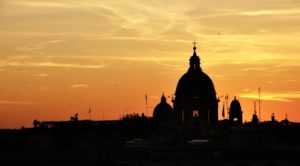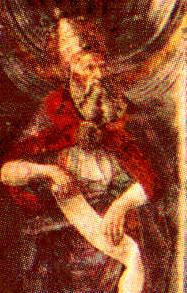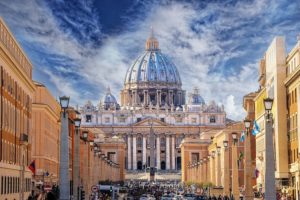
After the great fire of Rome in July, A.D. 64, the suspected arsonist, Emperor Nero himself, set the Imperial propaganda machinery into high gear to get the word out among the surviving populace that the conflagration had been the work of the tiny Christian community in the city. To strengthen his story, he cited the “weird” rituals of the “fanatical cultists,” their sacrilege by worshiping not the pagan deities of the Roman pantheon but an ”absurd” man-god instead, and their disloyalty to the state. As a clincher, Nero charged the followers of Christ with many other heinous crimes, including cannibalism. To support this last allegation, he quoted from Chrisitan writings: “Unless you eat my flesh and drink my blood you shall not have life in you.”
Moreover, he had the Senate enact legislation outlawing Christianity as a subversive organization, issuing a warrant for the arrest of the leaders of the “organization” (i.e. Peter and Paul) and launching the first persecution of the Christians. Eventually, the first Supreme Pontiff (i.e. the Bishop of Rome or Pope), Peter the Apostle, was arrested and forcibly taken to the unspeakable horror of the Mamertine Prison, adjacent to the Forum.
For nine months Peter suffered the brutalities of the jail guards and was then informed that Nero had given the word for his execution. Peter, along with some of his flock, was crucified before an enormous crowd jammed into the stadium known as the Circus of Nero, on the southern slope of Vatican Hill. Behind this race course was a public cemetery of streets lined with the mausolea of affluent pagan Romans. Adjoining these streets was a sort of potter’s field where the grieving friends of the apostle interred his remains
A Sacred Tomb
For the next quarter of a century or so, the location of the grave was marked – as a safeguard against desecration – only in the memories of these Christians. During this period too, an unofficial Christian necropolis developed around the grave of Peter since many – facing martyrdom – made it known that they wished to lie forever near their beloved bishop.

Pope Anacletus, as depicted on the wall of the Sistine Chapel. Wikimedia Commons, Public Domain
When in A.D. 90 the first pogrom against the Christians had abated somewhat, Anacletus, the second successor to St. Peter as Bishop of Rome, built a simple shrine directly over the grave of Peter. To this site would come, daily, groups of Christians in pious pilgrimage. These pilgrimages would, in the early centuries of the Church, cease each time a new wave of anti-Christian atrocities would be instigated by the state. Yet, as much as the government wished to suppress the infant religion, it would not go so far as to desecrate or destroy the grave of Peter, in compliance with its own statute, Violatio Sepulchri, which declared all burial grounds – Pagan, Jewish, Christian alike – to be inviolable.
A persistent tradition tells us, however, that the persecution by the Emperor Valerian in 257-258 was so savage that the Christians feared for the security of the apostle’s mortal remains and thus secretly exhumed them for transferral to the catacomb of St. Sebastian on the Appian Way. Graffiti and inscriptions in this subterranean necropolis (one reads: Domus Petri, Home of Peter) seem to corroborate the claim by some scholars that Peter was indeed for a short period entombed therein. Valerian did confiscate all Christian cemeteries during his reign of terror but when, under his successor Gallienus, these grounds were restored to the Christian community, the apostle’s relics were re-interred in their original grave, still indicated by a memorial.
A letter from about the year 200 by a certain Roman presbyter (priest) named Gaius perhaps refers to this shrine. From the letter and later archeological evidence we learn that the Christian community in time built a brick wall around their potter’s field to prevent further encroachment by pagan mausolea. Since the wall crossed directly over the apostle’s tomb, it incorporated into its fabric, at that point, a “trophy” as Gaius calls it. (Trophy in the ancient idiom meant monument.) This was either the memorial erected by Pope Anacletus or one by a later pontiff. From a manufacturer’s stamp in the tile of a drain in this plot it can be plausibly inferred that the wall project dates to about A.D. 150.
With the victory of Constantine over Maxentius in the famous battle of the Milvian Bridge, there opened a new chapter in the history of Rome and of Christianity. Crediting the Christians’ God for his victory, the new emperor, Constantine, in gratitude, gave two state properties (the Lateran and the Vatican) to the beleaguered community, ordered a temple to be built over the site of Christ’s tomb on Golgotha in the Roman province of Judea, and in 326 began the building of an immense, splendid five-aisle basilica to honor the apostle, with the main altar placed directly over the modest oratory of Anacletus.
Tradition informs us that Constantine was most reverential in caring for the holy remains. The Liber Pontificalis, a book of biographies of popes from St. Peter until the 15th century, describes how the tomb of the apostle was opened in the presence of Pope St. Sylvestor and the Emperor, the bones collected and placed in a small but precious chest of gilt bronze surmounted by a solid gold cross weighing 160 pounds, and entombed beneath the main altar of the massive church.
In 594, due to the troubled times, Pope Gregory the Great ordered the raising of the basilica’s floor so that the apostolic tomb, now a veritable repository of gold and silver and jewels, might be more secure out of sight. It could now be viewed only by going through a passage in the crypt beneath the church. Subsequent floor elevations and new altars by later popes, Clement VIII for one, relocated the tomb of Peter even deeper underground.
In 846, the hapless Eternal City was plundered by the non-Christian Saracens, who destroyed everything in their violent path and even plundered the temple and the tomb of Peter. From this point on there was to be no trace of Constantine’s gold cross and precious stones.
After the departure of the merciless Saracens, the damages to the great basilica were repaired by Pope Leo IV (who also raised the lofty fortifications that we still see today encircling the Vatican, which accounts for the enclave’s other name, “The Leonine City”). Nearly all of Leo’s successors continued to embellish the ancient church with rare and costly productions of old and contemporary Christian art. The European nations which had by now been illuminated by the glow of Christianity also sent marvelous gifts of art to enrich St. Peter’s.
The 1300’s marked the beginning of another significant chapter in the basilica’s history. Upon the election of the French Pope, CLement V, the papal residence was transferred, for political reasons, from Rome to the sleepy town of Avignon in southern France. Here the papacy stayed for 70 years. During that time St. Peter’s fell dark and abandoned. From sheer neglect the basilica began to deteriorate. Its south wall bulged outward more than six feet out of true and the roof started to collapse. In 1378, Pope Gregory XI brought the papal throne back to Rome, but too late to save the crumbling basilica.
Finally, in 1450, the decay of St. Peter’s had reached such alarming dimensions that the architects of Pope Nicholas VI exhorted him to raze the sacred edifice lest it someday fall down upon the Holy Father and his flock gathered there for a pontifical Mass. But Nicholas died before he could carry out his intention to level the old structure and replace it with a far more splendid one. It wasn’t until eight popes and more than a half century later that the Constantinian basilica was pulled down to make way for the magnificent St. Peter’s we know and love today.
Testing the Tradition
The passage of so many centuries notwithstanding, Catholic tradition continued to hold that St. Peter’s Church – both the old and the new – stood expressly as a monument over the grave of the apostolic prince, Peter. In 1939, the newly elected Pope Pius XII had the faith and the fortitude to put this tradition to the test. As preparations were being made in the grottoes under the basilica for the tomb of his predecessor Pius XI, the digging had accidentally led to the discovery of an ancient pagan burial ground. Pius XII then authorized further excavations far below the nave of the church and gave orders for a specific search for the tomb of St. Peter.
___________________________________

St. Peter’s Basilica. bmarxdueren, Pixabay.
___________________________________
Previous pontiffs had shied away from such a quest. One deterrent was the frightening warning by Pope Gregory the Great back in 594 that anyone who would commit such a sacrilege as to disturb the bones of the apostle would suffer awful consequences. Another was the well-documented calamity, coincidental or not, that accompanied the last disturbance of the holy earth around Peter’s grave. When the architect Bernini in the early 1600’s informed Clement VIII that the massive columns supporting his proposed bronze baldacchino would need strong and deep foundations that required extensive digging near the apostolic tomb, the Holy Father, acutely aware of Gregory’s curse, was most reluctant to grant permission. Bernini ultimately prevailed. Work was initiated, auspiciously, on the Feast of Sts. Peter and Paul, June 29.
Within a week, the foreman in charge of the work died. Hours following his death, his assistant passed away. Hysteria swept over Rome and intensified when a few days later another official involved in the project died. When the pontiff himself took seriously ill, a short time later, all the laborers walked off the job, terrified by the omens. Eventually the panic eased, Rome regained its composure, and Bernini, via a promise of pay raises, was able to get the diggers back to the task.
Through their work, Pius XII’s excavators found a cemeterial street lined with house-like sepulchers whose interiors contained niches with urns of ashes or bones of Romans from the Imperial Age. At the very least, this supported the long-standing belief that Constantine had built the original St. Peter’s over a cemetery.
The excitement in the Vatican became palpable when, early in the digging, deep and directly under the papal altar, a small, ruined, immured monument was uncovered, fitting the description of Gaius’ “trophy.” More exciting still, however, was the slab, undoubtedly a gravestone, found at the foot of this wall shrine. When upon raising the stone the excavators unfortunately found an empty grave — the long trail seemed to have come to a hopeless dead end.
Lost and Found
But a humble, learned professor from the University of Rome, Margherita Guarducci, was granted permission by Pius XII to continue the search. An expert in ancient graffiti, she spent the next six years scrutinizing the crude etchings on the wall above and near the vacant grave. In her customary scholarly thoroughness, Professor Guarducci wandered through the catacombs of Rome, comparing the etchings with the graffiti of the subterranean galleries to further authenticate the former.
One day she deciphered a Greek inscription near a recess in a side wall. It revealed this simple message: “Peter is within.” Now the professor examined the recess itself and was persuaded that it was indeed a burial niche for human bones. And though Constantine’s marble enclosure of this original shrine was gone, it would have doubtlessly incorporated this side wall, too.
Another dead-end? Not to the dedicated academic detective. Interrogating workmen who had helped in the digging from the start, she learned that a monsignor assigned to the excavation work had some 10 years earlier come upon some bones in the niche in question, gathered them in a box, and moved them to a nearby storage room. By this time, Pius XII and his successor John XXIII had entered the ages, and it was Pope Paul VI who authorized the professor to attempt to identify the relics. With the aid of fellow scholars from the university, she determined the bones to be those of a man of 60 or 70 in age. Some handfuls of soil and shreds of purple and gold fabric were also found in the box along with the bones. All of this, plus the inscriptions, in addition to what ancient writings and tradition had to say on the matter, added up to one irrefutable fact as far as Professor Guarducci was concerned: Here indeed were the mortal remains of Peter the apostle!
Tradition relates that he would have been about 70 years of age at his death and that he was buried in the earth. Constantine, in encasing the remains, would appropriately have wrapped them in precious cloth. As for the remains being found in a place other than that marked by Pope Anacletus, that was simple to explain: In an age where grave robbing and desecration were virtual national pastimes, Constantine, or someone in charge of the basilica soon after him, would likely have taken the precaution of transferring the holy relics to a safe, clandestine place nearby.
The evidence was persuasive enough to Pope Paul VI. On June 26, 1968, at a splendid ceremony in the Basilica, he settled the issue for the Catholic world. From the papal altar, sunlit by golden beams streaming through the little windows of Michelangelo’s dome, beneath the towering letters at the base of the cupola declaring: “TU ES PETRUS…” the Holy Father, 262nd successor to the apostle, announced that the remains of St. Peter, the Fisherman from Galilee, had been found.
Cover Photo Image, Top Left: View of St. Peter’s Basilica at sunset. Anna Klein, Pixabay
_______________________________
Advertisement





